Abstract
Crohn disease (CD) is a chronic, panenteric intestinal inflammatory disease. Its etiology is unknown. Analogous to the tuberculoid and lepromatous forms of leprosy, CD may have two clinical manifestations. One is aggressive and fistulizing (perforating), and the other is contained, indolent, and obstructive (nonperforating) [Gi]-berts, E. C. A. M., Greenstein, A. J., Katsel, P., Harpaz, N. & Greenstein, R. J. (1994) Proc. Natl. Acad. Sci. USA 91, 12721-127241. The etiology, if infections, may be due to Mycobacterium paratuberculosis. We employed reverse transcription PCR using M. paratuberculosis subspecies-specific primers (IS 900) on total RNA from 12 ileal mucosal specimens (CD, n = 8; controls, n = 4, 2 with ulcerative colitis and 2 with colonic cancer). As a negative control, we used Myobacterium avium DNA, originally cultured from the drinking water of a major city in the United States. cDNA sequence analysis shows that all eight cases of Crohn's disease and both samples from the patients with ulcerative colitis contained M. paratuberculosis RNA. Additionally, the M. avium control has the DNA sequence of M. paratuberculosis. We demonstrate the DNA sequence of M. paratuberculosis from mucosal specimens from humans with CD. The potable water supply may be a reservoir of infection. Although M. paratuberculosis signal in CD has been previously reported, a cause and effect relationship has not been established. In part, this is due to conflicting data from studies with empirical antimycobacterial therapy. We conclude that clinical trials with anti-M. paratuberculosis therapy are indicated in patients with CD who have been stratified into the aggressive (perforating) and contained (nonperforating) forms.
Full text
PDF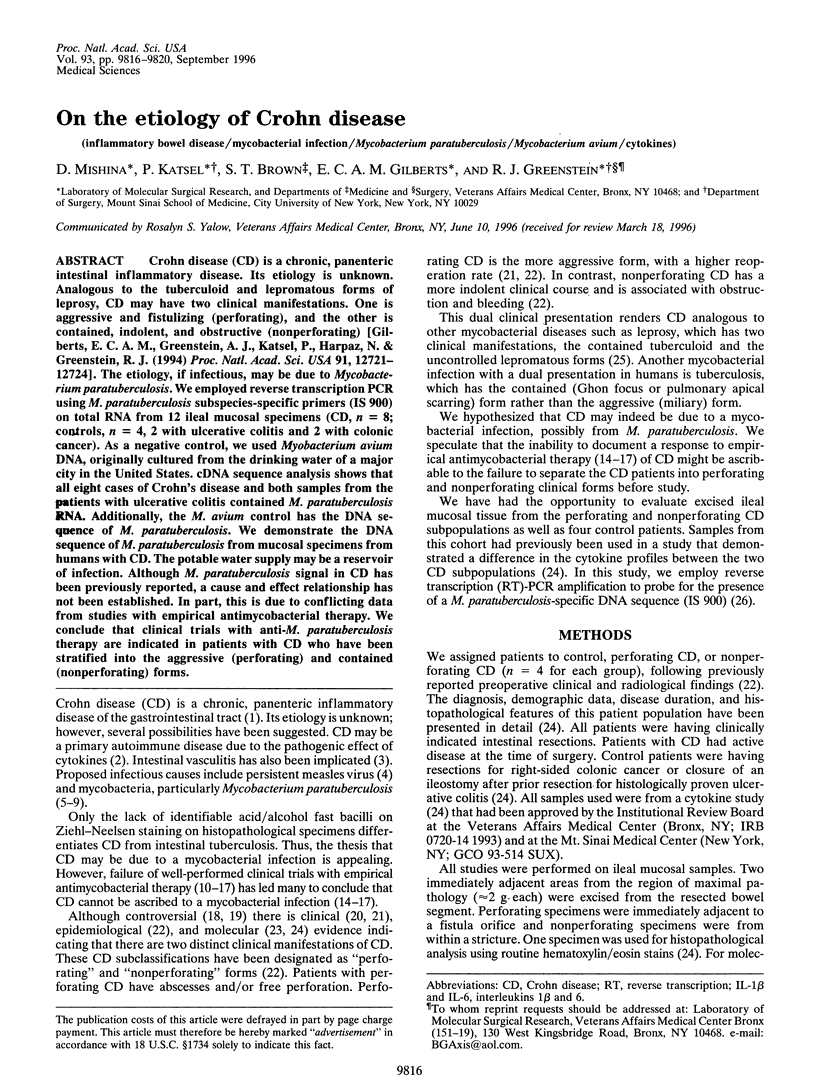
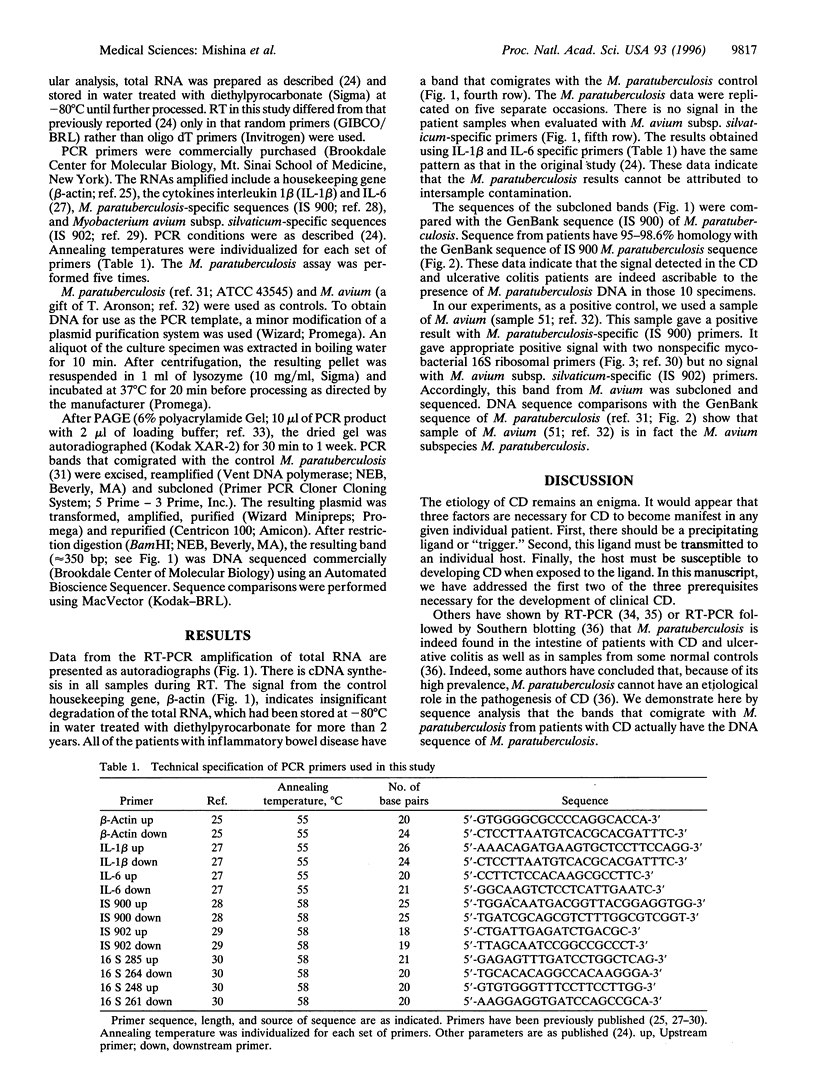
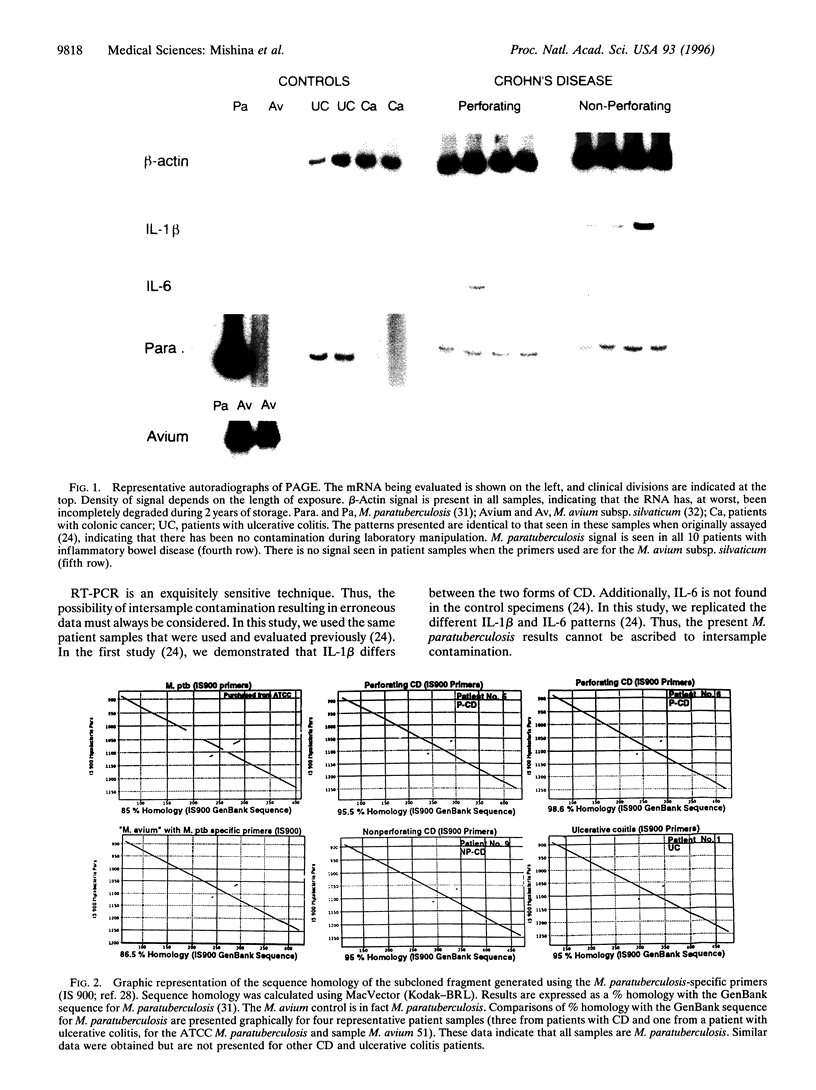
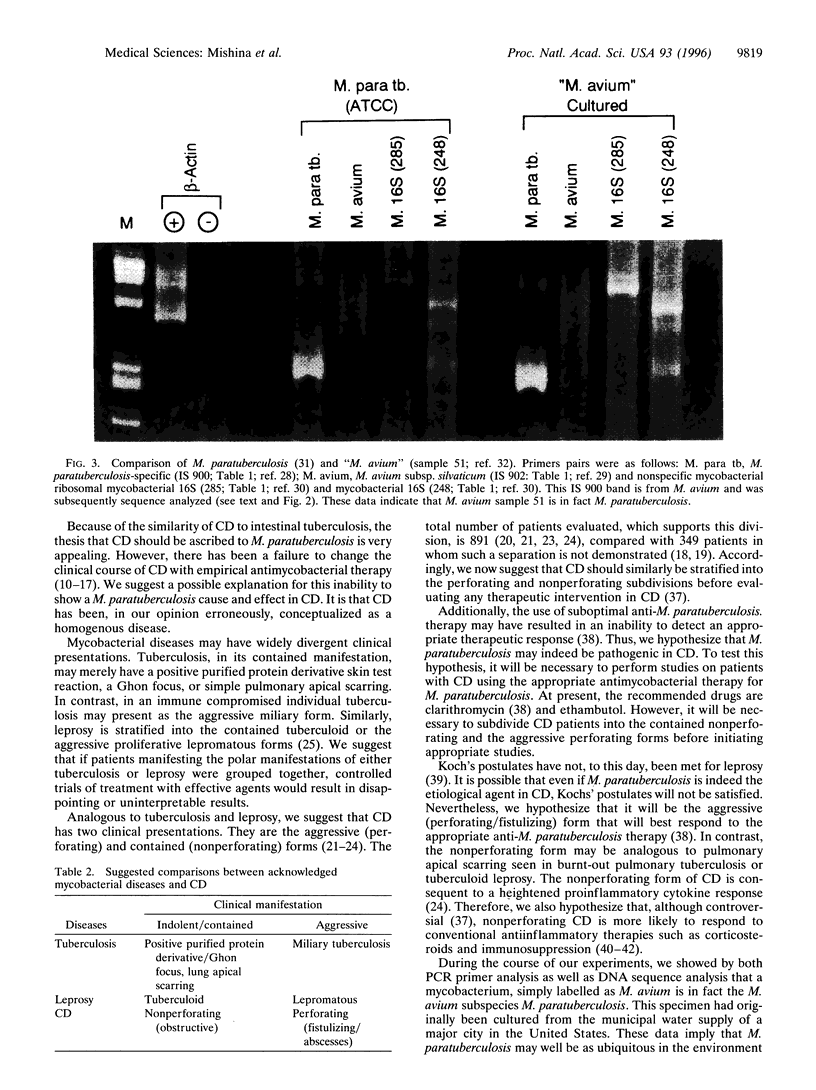
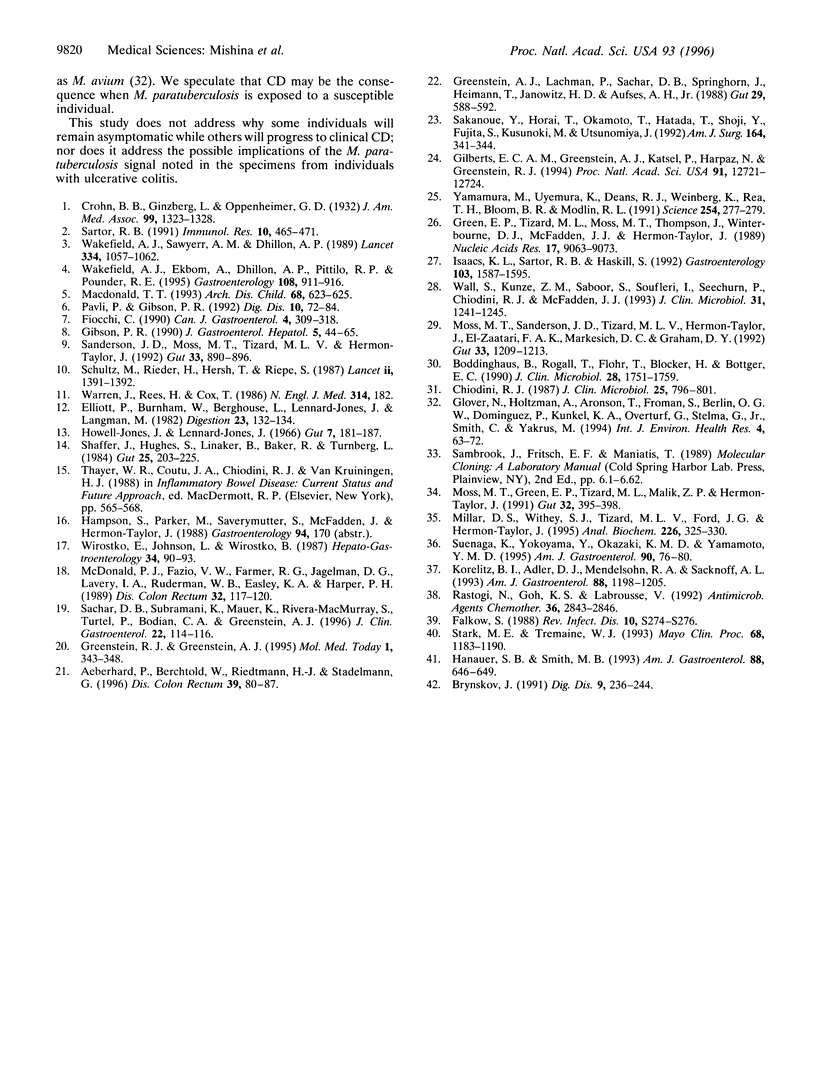
Images in this article
Selected References
These references are in PubMed. This may not be the complete list of references from this article.
- Aeberhard P., Berchtold W., Riedtmann H. J., Stadelmann G. Surgical recurrence of perforating and nonperforating Crohn's disease. A study of 101 surgically treated Patients. Dis Colon Rectum. 1996 Jan;39(1):80–87. doi: 10.1007/BF02048274. [DOI] [PubMed] [Google Scholar]
- Brynskov J. The role of ciclosporin therapy in Crohn's disease. A review. Dig Dis. 1991;9(4):236–244. doi: 10.1159/000171308. [DOI] [PubMed] [Google Scholar]
- Böddinghaus B., Rogall T., Flohr T., Blöcker H., Böttger E. C. Detection and identification of mycobacteria by amplification of rRNA. J Clin Microbiol. 1990 Aug;28(8):1751–1759. doi: 10.1128/jcm.28.8.1751-1759.1990. [DOI] [PMC free article] [PubMed] [Google Scholar]
- Elliott P. R., Burnham W. R., Berghouse L. M., Lennard-Jones J. E., Langman M. J. Sulphadoxine-pyrimethamine therapy in Crohn's disease. Digestion. 1982;23(2):132–134. doi: 10.1159/000198703. [DOI] [PubMed] [Google Scholar]
- Falkow S. Molecular Koch's postulates applied to microbial pathogenicity. Rev Infect Dis. 1988 Jul-Aug;10 (Suppl 2):S274–S276. doi: 10.1093/cid/10.supplement_2.s274. [DOI] [PubMed] [Google Scholar]
- Gibson P. R. Current concepts in the pathogenesis of Crohn's disease. J Gastroenterol Hepatol. 1990 Jan-Feb;5(1):44–65. doi: 10.1111/j.1440-1746.1990.tb01767.x. [DOI] [PubMed] [Google Scholar]
- Gilberts E. C., Greenstein A. J., Katsel P., Harpaz N., Greenstein R. J. Molecular evidence for two forms of Crohn disease. Proc Natl Acad Sci U S A. 1994 Dec 20;91(26):12721–12724. doi: 10.1073/pnas.91.26.12721. [DOI] [PMC free article] [PubMed] [Google Scholar]
- Green E. P., Tizard M. L., Moss M. T., Thompson J., Winterbourne D. J., McFadden J. J., Hermon-Taylor J. Sequence and characteristics of IS900, an insertion element identified in a human Crohn's disease isolate of Mycobacterium paratuberculosis. Nucleic Acids Res. 1989 Nov 25;17(22):9063–9073. doi: 10.1093/nar/17.22.9063. [DOI] [PMC free article] [PubMed] [Google Scholar]
- Greenstein A. J., Lachman P., Sachar D. B., Springhorn J., Heimann T., Janowitz H. D., Aufses A. H., Jr Perforating and non-perforating indications for repeated operations in Crohn's disease: evidence for two clinical forms. Gut. 1988 May;29(5):588–592. doi: 10.1136/gut.29.5.588. [DOI] [PMC free article] [PubMed] [Google Scholar]
- Greenstein R. J., Greenstein A. J. Is there clinical, epidemiological and molecular evidence for two forms of Crohn's disease? Mol Med Today. 1995 Oct;1(7):343–348. doi: 10.1016/s1357-4310(95)80034-4. [DOI] [PubMed] [Google Scholar]
- Hanauer S. B., Smith M. B. Rapid closure of Crohn's disease fistulas with continuous intravenous cyclosporin A. Am J Gastroenterol. 1993 May;88(5):646–649. [PubMed] [Google Scholar]
- Isaacs K. L., Sartor R. B., Haskill S. Cytokine messenger RNA profiles in inflammatory bowel disease mucosa detected by polymerase chain reaction amplification. Gastroenterology. 1992 Nov;103(5):1587–1595. doi: 10.1016/0016-5085(92)91182-4. [DOI] [PubMed] [Google Scholar]
- Jones J. H., Lennard-Jones J. E. Corticosteroids and corticotrophin in the treatment of Crohn's disease. Gut. 1966 Apr;7(2):181–187. doi: 10.1136/gut.7.2.181. [DOI] [PMC free article] [PubMed] [Google Scholar]
- Korelitz B. I., Adler D. J., Mendelsohn R. A., Sacknoff A. L. Long-term experience with 6-mercaptopurine in the treatment of Crohn's disease. Am J Gastroenterol. 1993 Aug;88(8):1198–1205. [PubMed] [Google Scholar]
- MacDonald T. T. Aetiology of Crohn's disease. Arch Dis Child. 1993 May;68(5):623–625. doi: 10.1136/adc.68.5.623. [DOI] [PMC free article] [PubMed] [Google Scholar]
- McDonald P. J., Fazio V. W., Farmer R. G., Jagelman D. G., Lavery I. C., Ruderman W. B., Easley K. A., Harper P. H. Perforating and nonperforating Crohn's disease. An unpredictable guide to recurrence after surgery. Dis Colon Rectum. 1989 Feb;32(2):117–120. doi: 10.1007/BF02553823. [DOI] [PubMed] [Google Scholar]
- McFadden J. J., Butcher P. D., Chiodini R., Hermon-Taylor J. Crohn's disease-isolated mycobacteria are identical to Mycobacterium paratuberculosis, as determined by DNA probes that distinguish between mycobacterial species. J Clin Microbiol. 1987 May;25(5):796–801. doi: 10.1128/jcm.25.5.796-801.1987. [DOI] [PMC free article] [PubMed] [Google Scholar]
- Millar D. S., Withey S. J., Tizard M. L., Ford J. G., Hermon-Taylor J. Solid-phase hybridization capture of low-abundance target DNA sequences: application to the polymerase chain reaction detection of Mycobacterium paratuberculosis and Mycobacterium avium subsp. silvaticum. Anal Biochem. 1995 Apr 10;226(2):325–330. doi: 10.1006/abio.1995.1232. [DOI] [PubMed] [Google Scholar]
- Moss M. T., Green E. P., Tizard M. L., Malik Z. P., Hermon-Taylor J. Specific detection of Mycobacterium paratuberculosis by DNA hybridisation with a fragment of the insertion element IS900. Gut. 1991 Apr;32(4):395–398. doi: 10.1136/gut.32.4.395. [DOI] [PMC free article] [PubMed] [Google Scholar]
- Moss M. T., Sanderson J. D., Tizard M. L., Hermon-Taylor J., el-Zaatari F. A., Markesich D. C., Graham D. Y. Polymerase chain reaction detection of Mycobacterium paratuberculosis and Mycobacterium avium subsp silvaticum in long term cultures from Crohn's disease and control tissues. Gut. 1992 Sep;33(9):1209–1213. doi: 10.1136/gut.33.9.1209. [DOI] [PMC free article] [PubMed] [Google Scholar]
- Pavli P., Gibson P. R. Pathogenic factors in inflammatory bowel disease. 2. Crohn's disease. Dig Dis. 1992;10(2):72–84. doi: 10.1159/000171346. [DOI] [PubMed] [Google Scholar]
- Rastogi N., Goh K. S., Labrousse V. Activity of clarithromycin compared with those of other drugs against Mycobacterium paratuberculosis and further enhancement of its extracellular and intracellular activities by ethambutol. Antimicrob Agents Chemother. 1992 Dec;36(12):2843–2846. doi: 10.1128/aac.36.12.2843. [DOI] [PMC free article] [PubMed] [Google Scholar]
- Sachar D. B., Subramani K., Mauer K., Rivera-MacMurray S., Turtel P., Bodian C. A., Greenstein A. J. Patterns of postoperative recurrence in fistulizing and stenotic Crohn's disease. a retrospective cohort study of 71 patients. J Clin Gastroenterol. 1996 Mar;22(2):114–116. doi: 10.1097/00004836-199603000-00008. [DOI] [PubMed] [Google Scholar]
- Sakanoue Y., Horai T., Okamoto T., Hatada T., Shoji Y., Fujita S., Kusunoki M., Utsunomiya J. Lipocortin-present perforating and lipocortin-absent nonperforating Crohn's disease. Am J Surg. 1992 Oct;164(4):341–344. doi: 10.1016/s0002-9610(05)80901-8. [DOI] [PubMed] [Google Scholar]
- Sanderson J. D., Moss M. T., Tizard M. L., Hermon-Taylor J. Mycobacterium paratuberculosis DNA in Crohn's disease tissue. Gut. 1992 Jul;33(7):890–896. doi: 10.1136/gut.33.7.890. [DOI] [PMC free article] [PubMed] [Google Scholar]
- Sartor R. B. Pathogenetic and clinical relevance of cytokines in inflammatory bowel disease. Immunol Res. 1991;10(3-4):465–471. doi: 10.1007/BF02919743. [DOI] [PubMed] [Google Scholar]
- Schultz M. G., Rieder H. L., Hersh T., Riepe S. Remission of Crohn's disease with antimycobacterial chemotherapy. Lancet. 1987 Dec 12;2(8572):1391–1392. doi: 10.1016/s0140-6736(87)91276-1. [DOI] [PubMed] [Google Scholar]
- Shaffer J. L., Hughes S., Linaker B. D., Baker R. D., Turnberg L. A. Controlled trial of rifampicin and ethambutol in Crohn's disease. Gut. 1984 Feb;25(2):203–205. doi: 10.1136/gut.25.2.203. [DOI] [PMC free article] [PubMed] [Google Scholar]
- Stark M. E., Tremaine W. J. Maintenance of symptomatic remission in patients with Crohn's disease. Mayo Clin Proc. 1993 Dec;68(12):1183–1190. doi: 10.1016/s0025-6196(12)60070-6. [DOI] [PubMed] [Google Scholar]
- Suenaga K., Yokoyama Y., Okazaki K., Yamamoto Y. Mycobacteria in the intestine of Japanese patients with inflammatory bowel disease. Am J Gastroenterol. 1995 Jan;90(1):76–80. [PubMed] [Google Scholar]
- Wakefield A. J., Ekbom A., Dhillon A. P., Pittilo R. M., Pounder R. E. Crohn's disease: pathogenesis and persistent measles virus infection. Gastroenterology. 1995 Mar;108(3):911–916. doi: 10.1016/0016-5085(95)90467-0. [DOI] [PubMed] [Google Scholar]
- Wakefield A. J., Sawyerr A. M., Dhillon A. P., Pittilo R. M., Rowles P. M., Lewis A. A., Pounder R. E. Pathogenesis of Crohn's disease: multifocal gastrointestinal infarction. Lancet. 1989 Nov 4;2(8671):1057–1062. doi: 10.1016/s0140-6736(89)91078-7. [DOI] [PubMed] [Google Scholar]
- Wall S., Kunze Z. M., Saboor S., Soufleri I., Seechurn P., Chiodini R., McFadden J. J. Identification of spheroplast-like agents isolated from tissues of patients with Crohn's disease and control tissues by polymerase chain reaction. J Clin Microbiol. 1993 May;31(5):1241–1245. doi: 10.1128/jcm.31.5.1241-1245.1993. [DOI] [PMC free article] [PubMed] [Google Scholar]
- Warren J. B., Rees H. C., Cox T. M. Remission of Crohn's disease with tuberculosis chemotherapy. N Engl J Med. 1986 Jan 16;314(3):182–182. doi: 10.1056/NEJM198601163140314. [DOI] [PubMed] [Google Scholar]
- Wirostko E., Johnson L., Wirostko B. Crohn's disease. Rifampin treatment of the ocular and gut disease. Hepatogastroenterology. 1987 Apr;34(2):90–93. [PubMed] [Google Scholar]
- Yamamura M., Uyemura K., Deans R. J., Weinberg K., Rea T. H., Bloom B. R., Modlin R. L. Defining protective responses to pathogens: cytokine profiles in leprosy lesions. Science. 1991 Oct 11;254(5029):277–279. doi: 10.1126/science.254.5029.277. [DOI] [PubMed] [Google Scholar]




